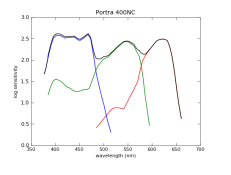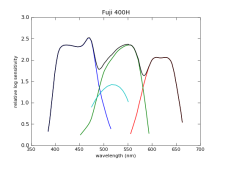I have a couple questions about Fuji's 4th color layer. This layer is cyan sensitive, presumably centered on the 'green spike' emitted by fluorescent lights. As I understand it, this effectively creates a mask proportional to this color, providing more natural color under fluorescent lighting.
My questions are:
1) Doesn't this harm color fidelity near this wavelength of light? If you took a picture of something of this color, doesn't the 4th layer work against you?
2) All the literature I've read about it says it's effective in fluorescent and 'mixed lighting'. I take 'mixed lighting' to mean combinations of fluorescent, metal halide, and other non-ideal light sources and daylight. Online in forums, it's often presented as tungsten + daylight. I can see the former, but not the latter. For the latter to be true, we'd need variable sensitivity to blue light, right? This often comes up in discussions of Portra 800 and Fuji 800z, as if 800z some how magically deals with tungsten light better. Of course, I'm not questioning it's ability to handle fluorescents in a way that the Portra does not.
I shot some Reala 500D in 16mm, which incorporates this 4th color layer, and it does do a great job of dealing with fluorescents. There's no denying that.
My questions are:
1) Doesn't this harm color fidelity near this wavelength of light? If you took a picture of something of this color, doesn't the 4th layer work against you?
2) All the literature I've read about it says it's effective in fluorescent and 'mixed lighting'. I take 'mixed lighting' to mean combinations of fluorescent, metal halide, and other non-ideal light sources and daylight. Online in forums, it's often presented as tungsten + daylight. I can see the former, but not the latter. For the latter to be true, we'd need variable sensitivity to blue light, right? This often comes up in discussions of Portra 800 and Fuji 800z, as if 800z some how magically deals with tungsten light better. Of course, I'm not questioning it's ability to handle fluorescents in a way that the Portra does not.
I shot some Reala 500D in 16mm, which incorporates this 4th color layer, and it does do a great job of dealing with fluorescents. There's no denying that.














